Ccoppola82
Well-known
Yup! Give it a shot. The reasoning behind doing this in my case at least, is because on roll film, we encounter scenes of varying contrast throughout the roll. This method provides a sort of fail safe to get printable negatives on all our shots.
When shooting large format, a photographer could measure an accurate reading for the shadows and highlights, and expose and develop for the perfect negative using N, N-, or N+ development because it is one negative at a time. We can’t do that with roll film, so we must make some sort of compromise in order to get useable images throughout our roll.
Another way to tackle the varying contrasts within a roll is two bath development. Just another way to approach the same problem. The theory behind that is that Bath A soaks up the developer into the emulsion, but the PH is such that it does not activate and little to no development takes place. In bath B, the PH activates the developer held in the negative. This exhausts the developer In the highlights quickly, thereby restraining them from blocking up, yet allows the shadows to develop slowly. We then end up with a relatively flat negative throughout the roll, which is good shadow and highlight detail. Again, adjust contrast in Post or darkroom with VC paper and contrast filters.
A great book to pick up is Barry Thornton’s “Edge of darkness” where I think a lot of this info is covered. Barry was a kick ass printer imho.
Good luck and get shooting!
When shooting large format, a photographer could measure an accurate reading for the shadows and highlights, and expose and develop for the perfect negative using N, N-, or N+ development because it is one negative at a time. We can’t do that with roll film, so we must make some sort of compromise in order to get useable images throughout our roll.
Another way to tackle the varying contrasts within a roll is two bath development. Just another way to approach the same problem. The theory behind that is that Bath A soaks up the developer into the emulsion, but the PH is such that it does not activate and little to no development takes place. In bath B, the PH activates the developer held in the negative. This exhausts the developer In the highlights quickly, thereby restraining them from blocking up, yet allows the shadows to develop slowly. We then end up with a relatively flat negative throughout the roll, which is good shadow and highlight detail. Again, adjust contrast in Post or darkroom with VC paper and contrast filters.
A great book to pick up is Barry Thornton’s “Edge of darkness” where I think a lot of this info is covered. Barry was a kick ass printer imho.
Good luck and get shooting!











